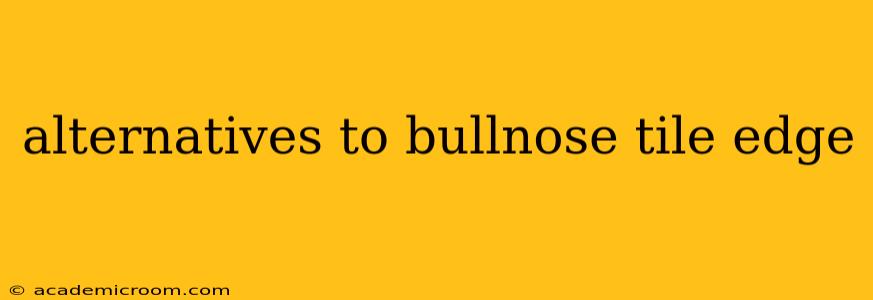Bullnose tiles, with their elegantly rounded edges, have long been a popular choice for finishing tile installations. However, they aren't the only option, and depending on your project, several alternatives might offer superior aesthetics, practicality, or cost-effectiveness. This guide explores the best alternatives to bullnose tile edges, helping you choose the perfect finish for your next tiling project.
What are the Benefits of Bullnose Tiles?
Before diving into alternatives, let's briefly cover why bullnose tiles are so popular. Their rounded edge provides a smooth, safe finish, eliminating sharp corners that could be a tripping hazard. They also offer a clean, polished look, enhancing the overall aesthetic appeal of a tiled area. However, bullnose tiles can be more expensive than other options and may not always be available in the exact color or style to match your main tiles.
What are the Alternatives to Bullnose Tile Edges?
Numerous alternatives offer a similar aesthetic and functionality to bullnose tiles without the limitations. Here are some of the most popular choices:
1. Pencil Molding
Pencil molding is a narrow, decorative tile strip with a rounded or beveled edge. It's a cost-effective alternative to bullnose tiles and comes in a wide variety of materials, colors, and finishes. Pencil molding is particularly versatile and often used to create a subtle yet elegant transition between different tile types or to add a decorative accent.
2. Cove Base
Cove base is a type of baseboard tile that features a concave curve, offering a smooth, seamless transition from the floor to the wall. It provides a clean look and can be a great option for areas prone to moisture, such as bathrooms and kitchens, as it helps to prevent water damage.
3. Schluter®-Systems Profiles
Schluter-Systems offers a range of profiles designed specifically for finishing tile edges. These profiles are typically made from durable materials like aluminum or PVC and are available in various shapes and colors. They provide a clean, modern finish and offer excellent protection against chipping and cracking. They are particularly useful for creating a clean transition between different tile types, or for finishing edges around showers and other wet areas. These profiles are installed at the same time as the tiles, creating a neat and professional finish.
4. Beveled Edge Tiles
Beveled edge tiles have a slightly angled edge, offering a sophisticated and modern look. While not as rounded as bullnose tiles, they still provide a smooth, safe finish. Beveled edge tiles are often used to create a striking contrast and add visual interest to a tiled area.
5. Using the Tile Itself (Proper Planning is Key!)
In some instances, the edge of your main tile can be utilized to create a finished look. This requires careful planning and precision cutting during installation. The right tools and a skilled tiler are essential for a professional outcome. This method can be highly cost-effective if done correctly.
What are the Pros and Cons of Each Alternative?
Each alternative has its advantages and disadvantages. Let's break them down:
| Alternative | Pros | Cons |
|---|---|---|
| Pencil Molding | Cost-effective, wide variety of styles, easy to install | Can be less durable than bullnose tiles |
| Cove Base | Seamless transition, moisture resistant, clean look | Limited style options compared to bullnose or pencil moldings |
| Schluter Profiles | Durable, variety of colors & styles, professional finish | Requires some specialized installation knowledge |
| Beveled Edge Tiles | Modern look, relatively easy to install | May not offer the same level of safety as rounded edges |
| Using Main Tile Edge | Cost-effective, consistent look | Requires precise cutting and skilled installation; potential for chipping |
Which Alternative is Right for Me?
The best alternative to bullnose tiles depends on your specific needs and preferences. Consider factors such as budget, desired aesthetic, the type of tile being used, and the location of the installation. If unsure, consulting with a professional tiler is always recommended. They can assess your project and recommend the most appropriate solution based on your unique requirements.
How Much Does Each Alternative Cost?
Costs vary greatly depending on materials, location, and labor costs. Pencil molding is generally the most affordable option, followed by using the main tile edge (assuming you have the skills or hire an experienced professional to do the precise cuts). Schluter profiles and cove base fall in the mid-range, while finding a precise match in beveled edge tiles might put it on the higher end of cost, comparable to traditional bullnose. Remember to factor in installation costs as these can vary significantly.
This comprehensive guide has explored several compelling alternatives to bullnose tile edges, providing valuable insights for your tiling project. Remember, selecting the right edge treatment is crucial to achieving a beautiful, functional, and long-lasting tiled space.
